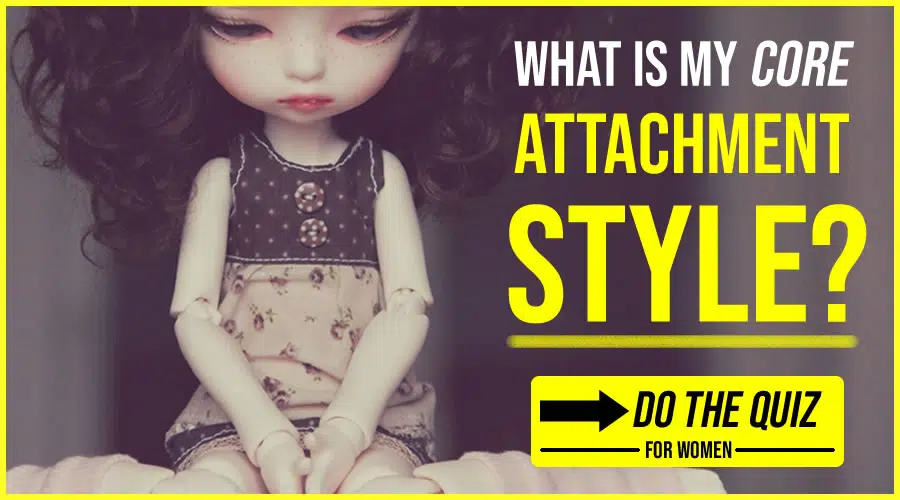So you’re wondering how to communicate to an avoidant partner?
Two things you need to know first:
Firstly, you need to know your own attachment style first. Because if you have a secure attachment style, you’ll find the process of communicating to an avoidant partner easier.
Whereas if you have an anxious attachment style, you’ll find the task borderline impossible.
MORE: The 4 Types Of Attachment Styles In Relationships & Which One’s Yours?
And secondly, you have to be sure that your partner is insecurely attached and does in fact, have an avoidant attachment style.
Because there’s a huge difference between dealing with someone who simply doesn’t perceive value in the relationship with you (and therefore avoids something serious with you), and someone who is truly an avoidant in love.
A lot of people avoid specific people in their life to a large or small extent, and sometimes it’s for healthy reasons.
Sometimes they’re avoiding committing more to the relationship, having a deeper conversation with you, or just avoiding you in general because:
- The relationship is still new enough that they’re feeling ambivalent
- They’re more committed to someone else
- They’re on a different timeline to you (which is common since men and women have different relationship timelines)
- You may have done something to hurt them
- They don’t perceive you to be the right one for them (and they just want to keep you around)
- They have other priorities
- They think you may be toxic
- They’ve been criticized one too many times
- They (especially men) are not clear about what you want, and just perceive your communications to be confusing or too indirect
Table of Contents
You Cannot Label Someone An Avoidant Until….
You cannot truly label someone to be an avoidant or as having an avoidant attachment style unless you become emotionally closer to them over time.
Because the whole purpose behind the attachment styles is to show us how comfortable we are with intimacy in our relationships.
So:
Unless you’ve truly gone beyond the surface with someone over time, you can’t truly tell.
Related: Why Do Men Pull Away? 9 Reasons + How To Stay High Value.
True Avoidants Are VERY Difficult To Deal With
Someone with an avoidant attachment pattern is understandably very difficult to communicate with.
You just have to be 100% sure that avoidant is indeed their attachment pattern, and not just that they don’t trust you specifically.
Make sense?
But let’s say you’re sure that your person has an avoidant attachment pattern.
Then this is what you need to do to communicate with them:
You are going to have to step into a deeply nurturing role with them in one way or another.
Why?
Because it is the only way to soothe the fear or anxiety within them that leads to the avoidant pattern.
Remember this:
Every avoidant person has been neglected as a baby and a child.
The reason they are avoidant is due to parental neglect – whether that be emotionally, physically, psychologically or mentally.
Their own parents and caregivers did not offer them a “secure base” from which to feel safe to:
- Explore life
- Be intimate
- To trust
- To learn freely
- To make mistakes
- To feel all of the emotions on the spectrum
- To develop a personality; and
- To have healthy emotional attachments with others
So if you truly love an avoidant, then you have to be that “secure base” that their caregivers did not give them.
Recommended: How To Fix An Anxious Avoidant Relationship: 7 Steps.
Now for all the ladies out there thinking that I’m asking too much of them…
I am not asking you to be the rehabilitation centre for a badly raised person, but…
In one way or another, you’re going to be kind of stepping into that role, because your avoidant partner is going to need your presence and compassion.
And even if you don’t think you’re being a rehabilitation centre, by being a safe place for your avoidant partner, you kind of are.
And if your goal is to actually know how to communicate to an avoidant partner, then generic advice like:
“Don’t be needy or suffocating.”
And…
“Be calm.”
Isn’t going to be enough for you to accomplish your goal. Even though it’s still useful advice – it’s not enough.
I’m not saying you need to do everything their parents didn’t do for them…
But I’m saying that you need to:
- Nurture them; and
- See them as the deeply hurt and abandoned human that they are
You will need to be able to hold space for them and believe in the fact that there is hurt and longing underneath all the avoidance, even if they vehemently resist that.
The question is:
Can you do that?
Are you ready for that commitment?
Can you offer:
- Nurturing
- Love; and
- Patience
…Even when they keep:
- Rejecting you
- Lying to you
- Choosing surface distractions over connecting with you; or
- Acting as though they don’t need you or your love
Can you do that over and over again….
Until their shell slowly crumbles?
Remember that you will be doing a job that is very hard.
If you’re up for that, kudos to you (you must really love him or her) and we can now move forward with how to communicate to an avoidant partner.
If you cannot do that (and I understand completely if you can’t), then please, move onto someone who will take less of your precious energy, time, and life away from you.
And I don’t say that to turn you off learning how to communicate to an avoidant partner.
I say that because it is going to be that hard. Let’s not sugar coat it.
Avoidant people can inflict a lot of pain and they are a lot of work – often far too much work to be worth the while.
As a parent, a coach in this realm for over a decade, and as a fellow human, I can tell you that it takes A LOT (of neglect or ignorance) to make someone a true avoidant.
On the very extreme of individuals with avoidant attachment, is where you get possible psychopaths as well.
So, be mindful and be ready.
If you’re up for it, then I’m here to help.

How To Communicate To An Avoidant Partner
Here is how to communicate to an avoidant partner: 11 genius ways.
#1: Know Their Strategy
So the first step in knowing how to communicate to an avoidant partner is to know their strategy.
What’s their strategy exactly?
Well if you look at their specific attachment style, the avoidant partially or completely shuts off their attachment needs, and they do it for specific reasons:
- Because they learned that this is the best and only way to keep their parent(s) around and still available to them
- Because facing the reality of having their needs ignored is too painful, so they employ a ‘deactivation” strategy in order to just survive
In other words, they’re avoidant in order to ensure:
- Survival
- Parental approval; and
- Hopefully some physical resources in a neglectful environment
So:
Know these things first of all.
Second of all, know that the avoidant is that way because they’re avoiding having to feel some extremely crippling emotions they were exposed to as a baby/child.
Emotions like:
- Shame
- Abandonment
- Humiliation
In some of the worst cases, an avoidant becomes completely devoid of emotion.
They’re seemingly no longer capable of softening into feeling all the emotion they had to reject, and they resort to horribly hurtful behaviors (which you may have experienced firsthand).
Think cold behavior that most reasonably secure people think is eccentric.
The fact that you’re searching how to communicate to an avoidant partner tells me that perhaps you’ve seen your particular partner soften before, and would like to see it again.
So it’s likely that your avoidant partner isn’t completely beyond ‘saving’ and nor are they at the furthest extreme of how avoidant attachment behavior manifests.
Now onto step number 2.
#2: Reassure The Hurt and Damaged Child Within
Before you can truly communicate with an avoidant partner, you have to give them the steady unconditional love that they need in order to feel safe.
So before you communicate your needs to them, or try to talk to them about something sensitive and important, you can try saying the following:
“I’m here, I’m not going anywhere. I love you, you can trust me.”
“You’re doing a great job of showing up in the relationship.” (lol. Ok so maybe most avoidants don’t do a great job of showing up, but on the occasions in which they do, you MUST reward it and commend them for it).
“It’s ok to feel hurt or angry.”
#3: Expect Testing
Don’t expect an avoidant to trust you like securely attached people would. Securely attached people are a special breed.
Relationships and intimacy are seemingly easier for these blessed individuals, and their interactions seem more fluid and calibrated.
You will not get that with an avoidant, at least not in the beginning. But do have hope that you may feel your avoidant partner trusting you if you are consistent.
Just know that to get there, you need to expect them to test you.
In fact, the more you give an avoidant love and reassurance, the more you need to expect them to test you.
Because they won’t believe it’s real.
They’ve been taught to cut off connection to their feelings and needs in order to survive or be worthy of attention, remember?
As such, they don’t trust emotions, and nor do they trust relationships.
So when you give them an opportunity to feel safe and to be loved in the relationship with you, their heart will open in love a tiny bit.
But it will also close very quickly in fear of feeling all that pain again.
So expect them to test your love and strength.
How many times?
I couldn’t tell you. Hopefully not many!
But each time you reassure them, the more they learn to trust connection, not detachment.
Remember that!
Our attachment styles are malleable, they can change along with our environment and adjust in order to match a securely attached partner.

#4: Find What Means Something To Them And Take An Interest In It
We all have something that interests us, even avoidants.
The goal here is to look for what they value, or what they connect to (if anything).
When you can find something that they value or connect to, then you can use that to connect with them, and remove some of their defences.
- Talk to them about it
- Encourage them to tell you more about it
- If you also enjoy it, take it up beside them!
If you want to know how to communicate to an avoidant partner, you have to remove their defences somehow and inspire them to communicate with you.
Sometimes the only way is to connect with them on something that they personally enjoy, rather than starting with your own complaints or worries.
Why?
To get past their guard! Once they let down their guard, that is the time to:
- Give them a gentle touch
- Hold their gaze longer than usual
- Praise them about their effort or skill
#5: Be Aware Of Why They Shy Away From Attachment & Do NOT Reject Them
Avoidants who are on the extreme end of avoidant attachment style tend to have already shut down their entire attachment system.
But those avoidants who aren’t quite as extreme are the ones you still have hope of communicating with.
So if your ultimate goal is to communicate with them, you need to be aware of why they don’t attach.
It’s certainly not because they don’t or didn’t want to. Somewhere deep down inside of some avoidants, they do want to attach.
They just can’t because if they did reach out and attach, they’d have to face a whole host of extremely painful emotions that were vehemently rejected in them.
So if you can show them that you won’t reject them, even when they’re being impossible, perhaps you can then begin to reach their soul.
Which brings us up to step 6.

#6: Hold Their Gaze & Connect To Their Soul
There’s no doubt about it – avoidants won’t hold your gaze for very long when being intimate.
As such, it’s a bit harder to develop that soul to soul connection.
Of course every avoidant is different. Most do still have a soul, and then there’s a minority who may not seem to have one – at least they’re not showing it.
You will just have to work hard to connect to it.
So the next step is to soften their shell by connecting to their soul.
The way to do this is to simply hold their gaze – try to feel any emotion that they feel.
This brings us to arguably, the MOST important step of how to communicate to an avoidant partner: speak to their inner child…
#7: Speak To The Inner Child
If possible, ask about their childhood. Ask them:
- What their relationship with mom and dad was like
- If they remember much from their childhood (and what they remember)
- Ask about the things they went through
- Ask about their relationships with their siblings and extended family
- Ask about their happiest experience
- Ask about their most painful experience (if you feel there’s a chance that they may tell you)
When you ask about the things they went through, listen carefully and look for the painful memories they are speaking of.
They may not feel the pain that much of course (they’re shut off to it). But you will.
Then:
Mention how awful it must have been, how lonely they must have felt.
This will slowly allow you to
- Help them name emotions for themselves; and
- Reactivate their attachment system and connect to them over time.
QUIZ TIME: What is my core attachment style? CLICK HERE to find out with our specially crafted women-specific 10 Question Quiz!
(Why is this important? It is because your core attachment style largely dictates and influences what happens in your relationship. Thus it’s imperative you understand your core attachment style!)
#8: Expect Anger To Show Up (And Be Prepared For It)
You do not deserve to be at the receiving end of anger that was created long before you even met your partner.
But unfortunately, if you’re having success on your quest to communicate with your avoidant partner, then you will see their anger at some stage.
Yes, their resentment will come out at some point, and it may come out at you in some way.
Whether it does or doesn’t depends on how discerning your partner is at when and where they spew their anger.
Hopefully, you’ll know that it’s not really about you and it’s not personal when their anger seems way out of proportion to what you said or did.
The truth is that friction and conflict is a natural progression of communicating with an avoidant person.
Remember:
They had to ingrain this avoidant attachment pattern just to survive.
This is a huge deal.
Avoidant attachment is not some kind of preference as the term attachment styles may suggest.
Instead, it has been a necessary pattern to ensure their own survival as a baby and child.
Just because they’re an adult now, doesn’t mean they’re suddenly going to just fear rejection less when trying to communicate.
So just remember that you will see their anger and you will encounter friction and conflict.
Because although you’re just loving them, sometimes they may feel you’re trying to disrupt their whole identity by making them feel vulnerable all over again (at the risk of being rejected all over again).
Your job is to know when enough anger is enough.
How much can you take?
You don’t want to ‘take’ your partner flying off the handle at you – when you’ve done nothing wrong. Right?
Right.
So:
- Don’t tolerate being their scratching post
- Don’t let them abuse you
- But also don’t undo any efforts you’ve made to communicate with them so far by flying off the handle back at them
Instead of making their anger wrong, the best thing to do is to simply state your boundaries.
- Tell them you understand
- Tell them that it’s ok to feel angry
- But it’s not ok to unleash so much anger at you just because you’re there, because it hurts you
Which brings us to the next step 9…

#9: Communicate Your Needs & Boundaries With Respect And Love
It may seem like you’re expected to be this highly tolerant saint here, and that is kind of what is required to know how to communicate to an avoidant partner.
At least in terms of your intent.
In order to succeed at communicating to them, you need to have only pure intent: to connect with them and communicate to them.
Once they sense that you’re just as untrustworthy and rejecting as their parent(s), they may not trust you again.
So whatever you say, make sure you’re not flipping out or getting abusive and violent. Try not to accuse them of things, but rather, simply state your boundary.
Here are some examples/scripts to get you started:
“I feel scared when things get heated like this. Could we both take some time to readjust?”
“It’s ok to feel angry. But it’s not ok to take it out on me.”
“I understand. I just need to take a break now to gather myself.”
#10: Re-Frame Their Idea Of Love & Relationships
By now you should have a good idea of how to communicate to an avoidant partner.
This part is where everything comes together.
When you feel like you’ve gotten through to your partner, this part kind of happens naturally.
This step is about reframing their idea of love and relationships.
What does that mean?
Essentially it means to change their internal model from avoidant to connected.
And you do this by following the previous steps. By following them, you’re being a steady, consistent place in which they can go for acceptance and love.
You cannot expect an avoidant to communicate with you or open up to you if you go to fight or flight or ‘lose it’ quite easily and if you don’t trust connection yourself.
#11: Reward Yourself
This is arguably one of the most important stages: you have to reward yourself for bothering to do this.
You’re taking on the task not only for yourself and for your partner, but on behalf of their parents who were not able to!
So you’re taking on the huge task of repairing the cycle of damage in their genetic line!
See how generous you are?!
So, reward yourself and give back to yourself.
Take a long bath, spend a weekend alone or with someone you love and go shopping, hiking, get a massage…whatever you perceive will relax you and make you happy.
You have to give to yourself in order to give to the one you love.
Final Words On How To Communicate To An Avoidant Partner
I hope these 11 steps above have helped you. I commend you on looking for answers on how to communicate to your partner, even though they’re difficult.
I wish you the greatest success!
And do not take abusive treatment just because you are attached to an avoidant!
But if it doesn’t work out with this partner, this can only make you stronger and better at loving through a future partner’s density.
I’m open to your thoughts and questions, so if you have any, please leave them below and I’ll get back to you as soon as I can.

P.S. CLICK HERE to check out my full article archives! Or you may greatly benefit from one of our highly popular paid programs, CLICK HERE to see what we offer right now.
If you want to be supported by a warm community of high value feminine women, then join our Facebook Group. (It’s free and so incredibly valuable!) CLICK HERE TO join thousands of other women in our “High Value Feminine Women” Community.
By the way, while you’re at it, connect with me on social media.
- Here’s my Youtube Channel The Feminine Woman.
- Here’s The Feminine Woman Facebook page…
- Here’s my Instagram Pages TheFeminineWoman & My Personal Instagram.
P.S. CLICK HERE to check out my full article archives! Or you may greatly benefit from one of our highly popular paid programs, CLICK HERE to see what we offer right now.
If you want to be supported by a warm community of high value feminine women, then join our Facebook Group. (It’s free and so incredibly valuable!) CLICK HERE TO join thousands of other women in our “High Value Feminine Women” Community.
By the way, while you’re at it, connect with me on social media.
- Here’s my Youtube Channel The Feminine Woman.
- Here’s The Feminine Woman Facebook page…
- Here’s my Instagram Pages TheFeminineWoman & My Personal Instagram.

Renee is the founder of The Feminine Woman & co-founder of Shen Wade Media where we teach women how to show up as a high value high status woman whom easily inspires a deep sense of emotional commitment from her chosen man. Together with her husband D. Shen at Commitment Triggers blog, they have positively influenced the lives of over 15 million women through their free articles and videos as well as 10’s of thousands through paid programs through the Shen Wade Media platform.
Connect deeper with her work through the social media links below.


